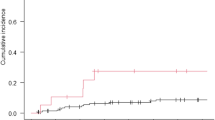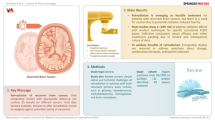Abstract
To evaluate risk profile, diagnostic yield and impact on treatment decision of stereotactic biopsy (SB) in elderly patients with unclear cerebral lesions. In this single center retrospective analysis we identified all patients aged ≥70 years receiving SB between January 2005 and December 2015. Demographic data, Karnofsky Performance Status (KPS), histology, comorbidity (by CHA2DS2-VASc Score) and use of anticoagulation were retrieved. We scrutinized diagnostic yield, procedural complications (mortality, transient and permanent morbidity), hospitalization time and therapeutic consequence. For correlation analysis Chi-Square, Mann–Whitney rank sum test and binary regression were used. Two hundred and thirty patients were included. In 229 patients SB was technically successful. Median age was 74 (70–87) years, 56.1% of patients were male and median preoperative KPS was 80% (30–100). Median CHA2DS2-VASc Score was 4 (1–9), with 29.6% receiving anticoagulation. Median hospital stay was 8 (2–29) days. Pathological diagnosis was conclusive in 97% revealing neoplastic lesions in 91.7% (high-grade glioma 62.6%, lymphoma 18.3%, metastasis 4.8%, low-grade glioma 3.0% and other tumors 3.0%) and non-neoplastic lesions in 5.3% of cases. Procedure-related mortality was 0.4%, transient and permanent morbidity occurred in 19 patients (8.3%) and eight patients (3.5%). Complication rate was not associated with any of the above-mentioned parameters. Adjuvant therapy was initiated in 171 (74.3%) patients. Decision against disease-specific therapy was only influenced by preoperative KPS (p < 0.001). SB in elderly patients is characterized by a favorable risk profile and high diagnostic yield, allowing tissue based therapeutic consequences even in patients with high comorbidity and anticoagulant medication.
Similar content being viewed by others
Abbreviations
- GBM:
-
Glioblastoma multiforme
- KPS:
-
Karnofsky Performance Status
- MRI:
-
Magnetic resonance imaging
- SB:
-
Stereotactic biopsy
- WHO:
-
World Health Organization
References
Wick W, Platten M, Meisner C et al (2012) Temozolomide chemotherapy alone versus radiotherapy alone for malignant astrocytoma in the elderly: the NOA-08 randomised, phase 3 trial. Lancet Oncol 13(7):707–715. doi:10.1016/s1470-2045(12)70164-x
Louis DN, Perry A, Reifenberger G et al (2016) The 2016 World Health Organization classification of tumors of the central nervous system: a summary. Acta Neuropathol 131(6):803–820. doi:10.1007/s00401-016-1545-1
Werner MH, Phuphanich S, Lyman GH (1995) The increasing incidence of malignant gliomas and primary central nervous system lymphoma in the elderly. Cancer 76(9):1634–1642
Chakrabarti I, Cockburn M, Cozen W et al (2005) A population-based description of glioblastoma multiforme in Los Angeles County, 1974–1999. Cancer 104(12):2798–2806. doi:10.1002/cncr.21539
Tanaka S, Meyer FB, Buckner JC et al (2013) Presentation, management, and outcome of newly diagnosed glioblastoma in elderly patients. J Neurosurg 118(4):786–798. doi:10.3171/2012.10.jns112268
D’Amico RS, Cloney MB, Sonabend AM et al (2015) The safety of surgery in elderly patients with primary and recurrent glioblastoma. World neurosurgery 84(4):913–919. doi:10.1016/j.wneu.2015.05.072
Lip GY, Nieuwlaat R, Pisters R et al (2010) Refining clinical risk stratification for predicting stroke and thromboembolism in atrial fibrillation using a novel risk factor-based approach: the euro heart survey on atrial fibrillation. Chest 137(2):263–272. doi:10.1378/chest.09-1584
Glotzer TV, Hellkamp AS, Lee KL et al (2015) CHA2DS2-VAS(C) and CHADS2 scores predict adverse clinical events in patients with pacemakers and sinus node dysfunction independent of atrial fibrillation. Can J Cardiol 31(8):1004–1011. doi:10.1016/j.cjca.2015.02.020
Ruge MI, Kickingereder P, Grau S et al (2011) Stereotactic biopsy combined with stereotactic 125iodine brachytherapy for diagnosis and treatment of locally recurrent single brain metastases. J Neurooncol 105(1):109–118. doi:10.1007/s11060-011-0571-z
Ruge MI, Suchorska B, Maarouf M et al (2011) Stereotactic 125iodine brachytherapy for the treatment of singular brain metastases: closing a gap? Neurosurgery 68(5):1209–1208. doi:10.1227/NEU.0b013e31820b526a (discussion 18–9)
Sturm V, Pastyr O, Schlegel W et al (1983) Stereotactic computer tomography with a modified Riechert-Mundinger device as the basis for integrated stereotactic neuroradiological investigations. Acta Neurochir 68(1–2):11–17
Ostrom QT, Gittleman H, Xu J et al (2016) CBTRUS statistical report: primary brain and other central nervous system tumors diagnosed in the United States in 2009–2013. Neuro-Oncology 18(suppl 5):v1–v75 doi:10.1093/neuonc/now207
Kelly PJ, Hunt C (1994) The limited value of cytoreductive surgery in elderly patients with malignant gliomas. Neurosurgery 34(1):62–66 (discussion 66–7)
Muacevic A, Kreth FW (2003) Quality-adjusted survival after tumor resection and/or radiation therapy for elderly patients with glioblastoma multiforme. J Neurol 250(5):561–568. doi:10.1007/s00415-003-1036-x
Field M, Witham TF, Flickinger JC et al (2001) Comprehensive assessment of hemorrhage risks and outcomes after stereotactic brain biopsy. J Neurosurg 94(4):545–551. doi:10.3171/jns.2001.94.4.0545
Chen CC, Hsu PW, Erich Wu TW et al (2009) Stereotactic brain biopsy: single center retrospective analysis of complications. Clin Neurol Neurosurg 111(10):835–839. doi:10.1016/j.clineuro.2009.08.013
Kreth FW, Muacevic A, Medele R et al (2001) The risk of haemorrhage after image guided stereotactic biopsy of intra-axial brain tumours–a prospective study. Acta Neurochir 143(6):539–545 (discussion 45–6)
Hall WA (1998) The safety and efficacy of stereotactic biopsy for intracranial lesions. Cancer 82(9):1749–1755
McGirt MJ, Woodworth GF, Coon AL et al (2005) Independent predictors of morbidity after image-guided stereotactic brain biopsy: a risk assessment of 270 cases. J Neurosurg 102(5):897–901. doi:10.3171/jns.2005.102.5.0897
Heper AO, Erden E, Savas A et al (2005) An analysis of stereotactic biopsy of brain tumors and nonneoplastic lesions: a prospective clinicopathologic study. Surg Neurol 64(Suppl 2):S82–S88 doi:10.1016/j.surneu.2005.07.055
Kickingereder P, Willeit P, Simon T et al (2013) Diagnostic value and safety of stereotactic biopsy for brainstem tumors: a systematic review and meta-analysis of 1480 cases. Neurosurgery 72(6):873–881 doi:10.1227/NEU.0b013e31828bf445 (discussion 82; quiz 82)
Malmstrom A, Gronberg BH, Marosi C et al (2012) Temozolomide versus standard 6-week radiotherapy versus hypofractionated radiotherapy in patients older than 60 years with glioblastoma: the Nordic randomised, phase 3 trial. Lancet Oncol 13(9):916–926. doi:10.1016/s1470-2045(12)70265-6
Author information
Authors and Affiliations
Corresponding author
Ethics declarations
Conflict of interest
The authors declared that they have no conflict of interest.
Rights and permissions
About this article
Cite this article
Kellermann, S.G., Hamisch, C.A., Rueß, D. et al. Stereotactic biopsy in elderly patients: risk assessment and impact on treatment decision. J Neurooncol 134, 303–307 (2017). https://doi.org/10.1007/s11060-017-2522-9
Received:
Accepted:
Published:
Issue Date:
DOI: https://doi.org/10.1007/s11060-017-2522-9




